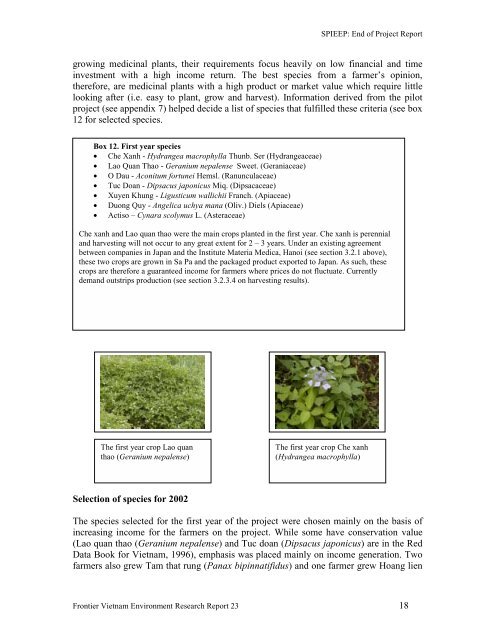Frontier Tanzania Environmental Research - Frontier-publications ...
Frontier Tanzania Environmental Research - Frontier-publications ...
Frontier Tanzania Environmental Research - Frontier-publications ...
You also want an ePaper? Increase the reach of your titles
YUMPU automatically turns print PDFs into web optimized ePapers that Google loves.
SPIEEP: End of Project Reportgrowing medicinal plants, their requirements focus heavily on low financial and timeinvestment with a high income return. The best species from a farmer’s opinion,therefore, are medicinal plants with a high product or market value which require littlelooking after (i.e. easy to plant, grow and harvest). Information derived from the pilotproject (see appendix 7) helped decide a list of species that fulfilled these criteria (see box12 for selected species.Box 12. First year species• Che Xanh - Hydrangea macrophylla Thunb. Ser (Hydrangeaceae)• Lao Quan Thao - Geranium nepalense Sweet. (Geraniaceae)• O Dau - Aconitum fortunei Hemsl. (Ranunculaceae)• Tuc Doan - Dipsacus japonicus Miq. (Dipsacaceae)• Xuyen Khung - Ligusticum wallichii Franch. (Apiaceae)• Duong Quy - Angelica uchya mana (Oliv.) Diels (Apiaceae)• Actiso – Cynara scolymus L. (Asteraceae)Che xanh and Lao quan thao were the main crops planted in the first year. Che xanh is perennialand harvesting will not occur to any great extent for 2 – 3 years. Under an existing agreementbetween companies in Japan and the Institute Materia Medica, Hanoi (see section 3.2.1 above),these two crops are grown in Sa Pa and the packaged product exported to Japan. As such, thesecrops are therefore a guaranteed income for farmers where prices do not fluctuate. Currentlydemand outstrips production (see section 3.2.3.4 on harvesting results).The first year crop Lao quanthao (Geranium nepalense)The first year crop Che xanh(Hydrangea macrophylla)Selection of species for 2002The species selected for the first year of the project were chosen mainly on the basis ofincreasing income for the farmers on the project. While some have conservation value(Lao quan thao (Geranium nepalense) and Tuc doan (Dipsacus japonicus) are in the RedData Book for Vietnam, 1996), emphasis was placed mainly on income generation. Twofarmers also grew Tam that rung (Panax bipinnatifidus) and one farmer grew Hoang lien<strong>Frontier</strong> Vietnam Environment <strong>Research</strong> Report 23 18
















